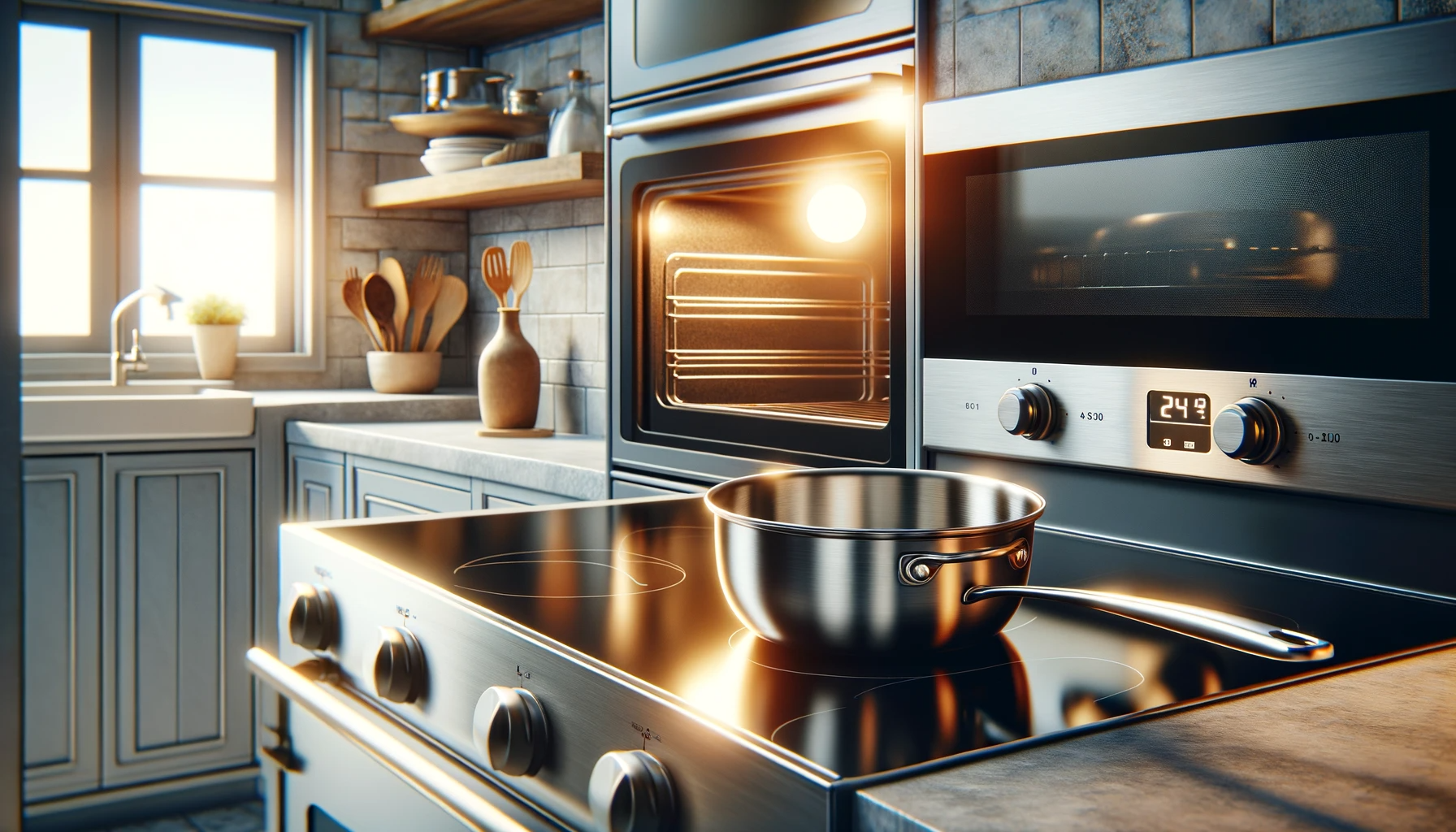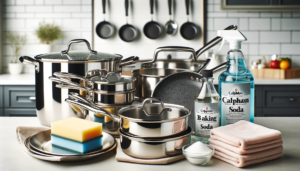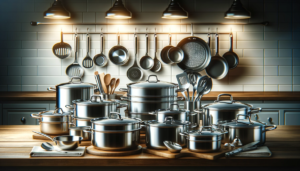Ever pulled a pan out of the oven only to find its plastic handle melted onto the rack? Mishaps like this make cooks wary to mix stainless steel cookware and high oven heat.
Understanding stainless steel’s material limits provides the answer on how it can transition safely from stovetop searing to oven baking.
Let’s examine when stainless steel handles oven environments with ease versus when to take caution.
Stainless Steel Cookware Is Often Oven-Safe
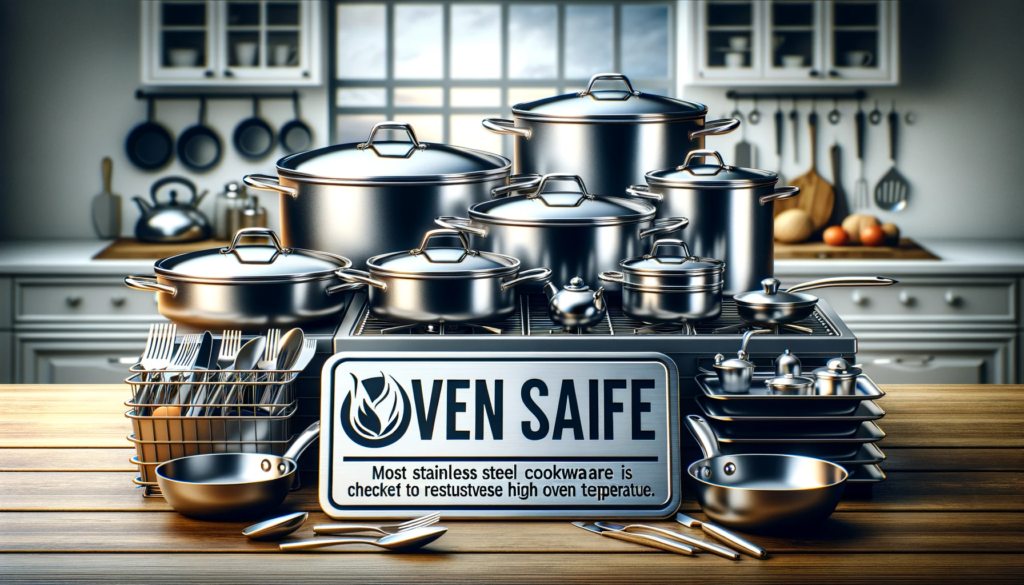
Most pots, pans, and bakeware made from stainless steel are safe to use in an oven up to certain temperatures.
The stainless steel material itself is durable enough that it can withstand the high heat of an oven without warping, melting, or sustaining other damage.
Stainless steel’s high resistance to heat makes it an ideal choice for cookware that transfers between the stovetop and oven.
Before placing any stainless steel cookware into the oven, be sure to check the manufacturer’s specifications to confirm the maximum oven-safe temperature.
Just because stainless steel itself can take high heat does not guarantee that all cookware made from it has the same heat tolerance.
But in most cases quality stainless steel pots, pans and baking dishes can go into a hot oven for cooking or baking purposes.
When checking the specifications on stainless steel cookware before oven use, look for specific mentions of oven safety and maximum heat tolerance.
Quality cookware designed for multi-use should be clearly labeled as such.
Stainless steel cookware not intended for the oven may have lower melting points for attached handles and lids, so the specifications should differentiate between types.
Always check for certification by safety organizations as another indicator that stainless steel cookware can withstand oven temperatures.
While not a guarantee, responsible manufacturers will adhere to rigorous material standards.
Temperatures to Avoid
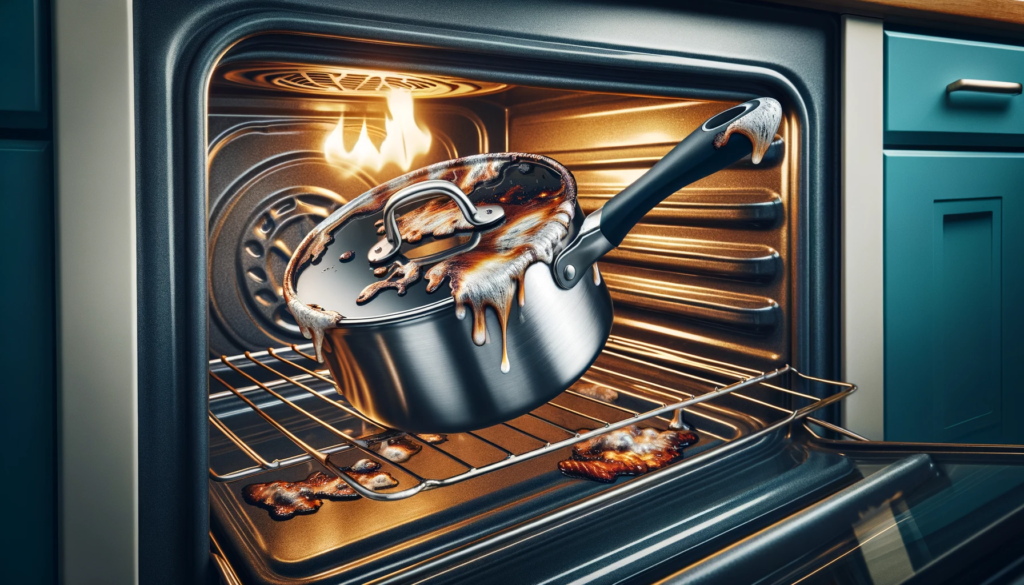
While stainless steel cookware may have a high oven-safe rating, the handles on that cookware could be more limited in high temperatures.
Cookware handles are often made of materials like plastic, wood, or silicone in order to stay cool while on the stovetop.
However, these materials may start to melt, burn, or become brittle at sustained high oven temperatures.
Before putting a stainless steel pot or pan into the oven, check that its handle is also rated for high heat.
If not, it is best to remove lids, handles and knobs before placing the stainless steel cookware into the oven.
Handles and lids should be removed not just for baking pans but also pots and pans that go from stovetop to oven.
Leaving them on can cause burns or risk the handles melting onto the oven’s interior.
In addition to removing handles, cooks should avoid using the oven’s broiler setting when stainless steel pans are inside.
The broiler causes intense direct top-down heat which could exceed some cookware’s ratings.
Always check stainless steel cookware specifications before broiler use.
Even quality stainless steel under the broiler risks warping without enough air circulation underneath.
The close proximity to the overhead heating element is harsher than conventional oven baking.
While durable, stainless steel cookware not designed for broiler use can sustain damage or warp when exposed to extremely high and sustained direct heat.
Tips For Oven Use

When preparing to use stainless steel cookware in the oven, there are some tips to follow:
Fully preheat the oven before placing stainless steel pots, pans or bakeware inside.
Dropping cool stainless steel into a very hot oven risks cracking or warping.
Thermal shock happens when a temperature change is too sudden, so always allow stainless steel cookware to adjust.
Remove cookware from the refrigerator well in advance before oven use.
Never place chilled or room temperature stainless steel into an oven preheated to over 300 degrees Fahrenheit.
Gradual adjustment allows the stainless steel to expand slowly as heat builds.
Use potholders when handling stainless steel cookware after oven cooking.
While stainless steel itself does not get hot in the same manner as metal, the handles will be extremely hot after oven use.
Proper hand protection is a must.
Stainless steel is an excellent heat conductor, so while pans seem cool to the touch, heat will transfer through handles rapidly.
Always opt for thick potholders over towels for the best insulation after removing stainless steel pans, pots and dishes from the oven.
Closed-glove potholders protect hands and fingers from steam as well.
Avoid letting stainless steel cookware touch the sides or heating element while baking.
The direct contact can cause food to burn and stainless steel to warp.
Leave space between pans and oven walls.
Like the broiler setting, letting stainless steel cookware touch oven walls or coils exposes it to intense direct heat without the protection of air circulation.
The most severe hot spots happen nearest heating elements, so keep a buffer distance.
Heat-resistant oven racks are best for airflow and preventing direct contact.
When baking with stainless steel sheets, pans or dishes, use the oven racks recommended in the cookware’s instructions.
This allows for proper air circulation so the metal heats evenly and avoids hot spots.
Stainless steel conducts heat quickly, so gaps below and around the cookware prevent overheating.
Leave at least .5-1 inch between pans and oven walls for air flow.
As stainless steel pans will heat rapidly once inside, allow space so heat distributes gently without scorching cookware or food.
Check pans before use and clean thoroughly after use to prevent oil spills or drips which could smoke heavily during high oven heat.
Stainless steel should not smoke if properly prepped and cleaned.
Oil droplets left from stovetop cooking can lead to flare ups when subjected to high oven heat.
Avoid this by wiping pans down before oven use.
Uncleaned pans also run the risk of transferring flavors between savory and sweet dishes, so proper cleaning protects taste.
Benefits Of Oven-Safe Stainless Steel Cookware
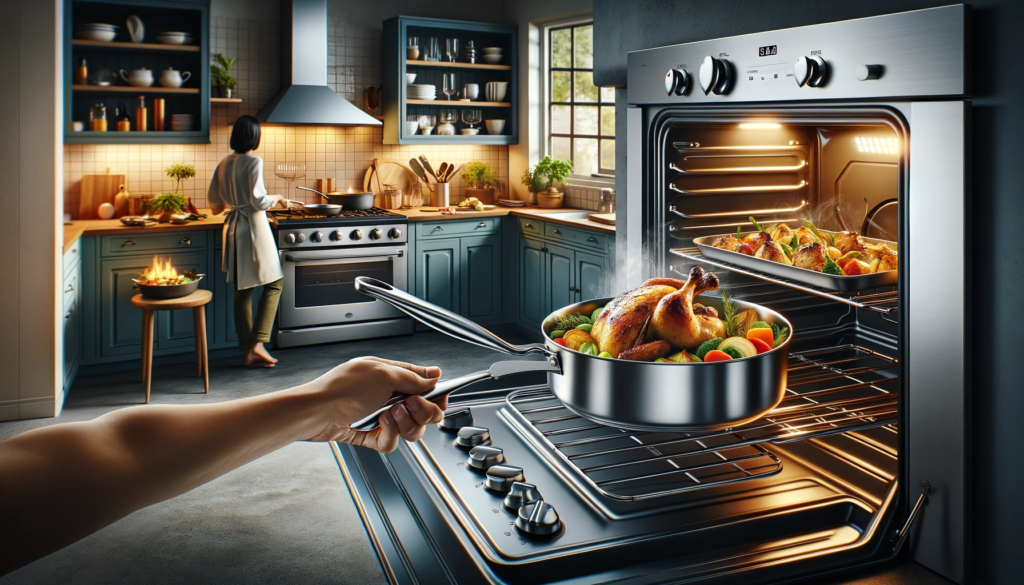
There are several advantages to using stainless steel pots, pans and baking dishes that can transition from stovetop cooking to oven use:
Cooks can conveniently use just one pan or pot on the stovetop before transferring it straight into the hot oven.
This saves clean up time since only one dish gets used.
Rather than dirtying multiple pans, oven-safe stainless steel allows the same pot or pan to be moved seamlessly between stove and oven during the cooking process.
Many dishes like roasted chicken or caramelized vegetables begin with stovetop searing or boiling before longer oven cooking.
Stainless steel excels for recipes with these steps.
Oven-safe stainless steel allows recipes to use higher sustained heat than other materials which have lower melting points or heat tolerance.
Temperatures can get significantly hotter than possible with nonstick or other bakeware.
For example, while nonstick pans often carry warnings against use over 400 degrees Fahrenheit, stainless steel often has no upper limit besides the oven setting itself.
This means stainless steel can brown and crisp through very high heat roasting, broiling or baking.
Quality stainless steel cookware stands up well to wear-and-tear over time.
Even with repeated oven use, it resists warping and stains better than many other bakeware options.
This makes it a durable long-term investment.
As an essentially nonreactive metal, quality stainless steel retains an unaltered cooking surface through many cycles in dishwashers and ovens.
No protective coating exists to scratch or flake off over time.
Stainless steel maintains its integrity through years of use.
The metal construction of stainless steel allows for better browning and crisping directly on the cookware surface when baking.
This gives better results for items like oven-baked chicken, fries, pastries and more.
With direct contact to the stainless steel, heat transfers rapidly for a sear similar to frying.
Food caramelizes well without sticking.
Many other baking sheets have coating between the food and metal, slowing browning.
Stainless steel makes the ideal material for fast, crispy baking dishes.
So while stainless steel on its own can resist high oven heat, cooks should always check manufacturers’ guidance on actual cookware products before assuming oven safety.
But when purchased from reliable brands, most stainless steel pots, pans and baking sheets can go directly into hot ovens for ease of cooking between stovetop and oven.
Handled properly, stainless steel cookware handles oven environments with ease.
Conclusion
In conclusion, most quality stainless steel cookware can be used safely in ovens, but there are certain precautions to take.
Always check manufacturer guidance on maximum heat tolerance, remove non-oven safe handles, allow for proper airflow, and handle hot pans carefully.
When these steps are followed, durable stainless steel pots, pans and baking dishes excel for high-heat cooking flexibility from the stovetop into the hot oven.
